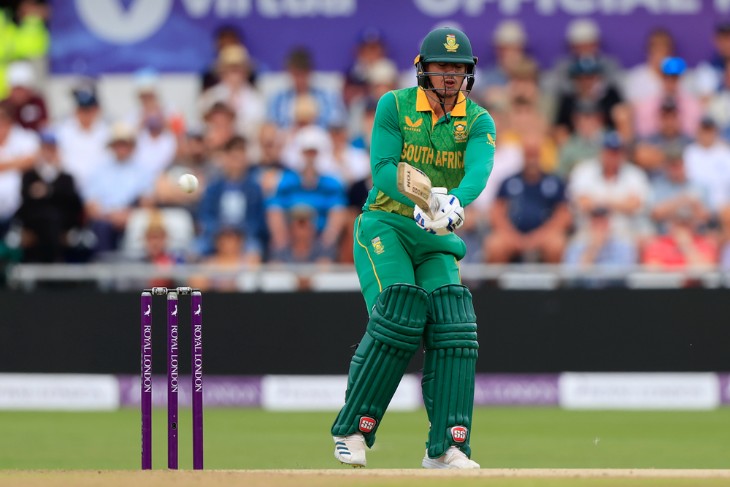- What does Soft Signal mean in Cricket?
- The Origin and Purpose of Soft Signal in Cricket
- Technology’s Role in Assisting with Soft Signal Decisions
- Controversies Surrounding Soft Signal in Cricket
- Implications of Soft Signal on Players and Match Outcomes
- The Future of Soft Signal in Cricket: Possible Changes and Improvements
- Balancing Technology and Human Judgement in Cricket's Decision-Making
- Players' and Fans' Perspectives on the Soft Signal Rule
- Final Verdict
Continuously being modernized with fresh regulations and terminologies, Cricket is a sport that millions adore and follow. Among them, "soft signal" has become quite popular in international cricket in particular. Often, such a term is raised during games and it surprises some supporters. In this article, we explore what soft signal in cricket means, its importance and the controversies associated with it.
What does Soft Signal mean in Cricket?
Cricket has a simple concept called "soft signal" which you might hear while watching a game. It is an integral part of the game that should not be ignored. The soft signal comes into play about a close catch or indecisive outcome. When such things happen, there will be no time to lose for on-field umpires who have to make a quick decision at first instance which may be referred to as soft-signal. They can either say 'OUT' or 'NOT OUT' based on what has gone through their mind concerning the incident at hand as well as previous experiences of similar cases that had occurred previously this season. Thus, one must keep in mind that this is not the final decision.
After giving the soft signal, umpires often seek a third umpire's assistance. The third umpire is off-field and has access to views from different cameras. What was the on-field umpire thinking? That's where the idea of "soft signal" comes from – meaning now the third umpire knows what was going inside the on-field official's head when taking his decision call; however, it does not imply he could agree with him every time about its authenticity because sometimes even video replays show us clearly if the initial judgment made by those officials were wrong or right
This means respecting the view of an on-field referee by having a soft signal like the presence of technology cannot interfere but rather enhance human subjectivity involved within it at all times without losing its essence.
Nevertheless, there are times when employing the soft signal may be a source of controversy. Hence, if the on-field umpires cannot see what happened during an incident, this may create some dissonance with the video footage. As a result, debates would arise as to whether the right decision was made or not. On the whole, soft signals are critical in cricket for making fair decisions still it keeps alive the importance of the umpire in that sport.
The Origin and Purpose of Soft Signal in Cricket
- Introduction: The introduction of "soft signal" marks its incorporation into the game as technology came into play within cricket. With more technology coming into cricket there was a need to keep alive the importance of the on-field umpire's role. Thus, the soft signal was brought in place to maintain that balance. It ensures that the umpire on the field continues having his voice in determining all matters concerning various game situations. This was important because cricket has always valued the umpire's judgment.
- Dealing With Inconclusive Evidence: Soft signals have sometimes been used when this aspect has been unclear on video replays leading to indecisiveness by third umpires at times and thus acting as guides. At times when you can't make a decision based only on watching a video, soft-signal comes in handy as it offers a starting point and mostly third empire remains with it unless that video does not show clearly otherwise if it is wrong (sic). It helps in making decisions without relying entirely on technology.
- Maintaining The Spirit of The Game: Cricket is known for being a game of spirits and traditions. Soft signals have played a vital role in keeping these traditions. It respects the on-field umpire's responsibility which is key to the game of cricket. With regards to technology, the soft signal ensures that it does not take over and completely controls the game. It brings about a balance between utilizing technology and respecting decisions made by umpires.
Technology’s Role in Assisting with Soft Signal Decisions
The use of technology helps a lot when it comes to making soft signal decisions in cricket. They use it to get a better picture when they are not sure about their decision on the field. This could be slow-motion replays or perhaps high definition camera capturing events from different angles among many other hi-tech tools available for this purpose that are at the third umpire's disposal. This can also include slow-motion replays to get an up-close view of what occurred.
Hawk-Eye is one such important technology used to track the path of the ball and make lbw decisions. Others such as Snickometer or UltraEdge help determine if the ball was hit before it got to be fielded by someone else on its way down from the bat. These technologies avail more information to third umpires who have been considering whether given by fielders like signals were correct or incorrect.
Nevertheless, technology doesn't always give definite answers. At times, the footage may be unclear thus no conclusive decision can be made based on it exactly. That is why in some cases, when video evidence is inconclusive, most Third Empire officials still go along with the soft signal. This has brought a lot of controversies over whether this is fair. Many say if video evidence isn't clear then the benefit should go towards batsmen or bowlers rather than soft signals as some claim. This debate revolves around how best to incorporate technology into cricket.

Controversies Surrounding Soft Signal in Cricket
- Pressure on On-Field Umpires: The major issue is the pressure on the on-field umpire when making a soft signal. They have to give a soft signal even if they are not sure about their decision. This can be difficult, especially in such situations as a fast game or when an incident happens far from them. Critics opine that this can result in giving wrong or incorrect soft signals which could eventually lead to the final decision being compromised.
- Challenges with Inconclusive Video Evidence: Another issue is when video evidence is inconclusive. Some feel that this undermines fairness and should not be encouraged as it does not assist anyone. Some however think that if videos are unclear, then the batsman or bowler rather than a soft signal gets the benefit of the doubt. This argument looks at ways through which technology can be utilized further in cricket.
- Calls for Rule Changes: As such controversies continue to arise; there has been an increased demand for some changes to the rule of soft signal. Thus, there has been an argument that sometimes we may need less use of soft signals or even remove them completely. People argue that once you have modern-day technology at your disposal like the third empire, there would be no need for a soft signal since he/she would make decisions without one. Others still see relevance in keeping it though needing certain modifications. The discussion rages on what the way forward will look like.
Implications of Soft Signal on Players and Match Outcomes
- Effect on Players: Players may be very much affected by the soft signal. Wrong soft signals can lead to wrong outs or not outs of players. It is something that makes players feel frustrated and annoyed as it can also hinder their performance for the rest of the match. The decisions should be fairly made and failure to do so considerably affects their confidence in the process of making such decisions.
- Influence on Match Outcomes: The outcome of matches can be changed by decisions based on a soft signal. Sometimes cricket matches are decided by narrow margins. One decision could change everything about the game. If a key player gets wrongly given out or not because of a soft signal, then this has an enormous effect on the entire match. For instance, if this happens in big tournaments like the World Cup, teams and fans face difficult times.
- Calls for Fairer Decisions: These impacts have led to calls for fairer decisions in cricket. Players, coaches, and fans want the best use of technology. They want decisions to be as accurate as possible. The soft signal is part of this debate. Cricket authorities are looking at how to make sure the game is fair and enjoyable for everyone.
The Future of Soft Signal in Cricket: Possible Changes and Improvements
The future of the soft signal in cricket could see some changes and improvements. One idea is to use more advanced technology. This could help in making clearer decisions, especially in close-catch situations. Another idea is to change the rules around the soft signal. For example, some suggest that the soft signal should not be used for catches far from the umpire. This is because the umpires might not have a clear view of what happened.
Cricket authorities are always looking for ways to improve the game. They listen to feedback from players, coaches, and fans. They also look at how technology is changing. Their goal is to make cricket as fair and enjoyable as possible.
Some people think the soft signal should be removed altogether. They argue that with all the technology available, the third umpire should decide without a soft signal. Others believe the soft signal is important. They say it respects the umpire's role and judgement on the field.
Whatever changes are made in the future, they will aim to keep the balance between technology and human judgment. The goal will always be to make cricket a fair and exciting game for everyone.

Balancing Technology and Human Judgement in Cricket's Decision-Making
In cricket, finding the right balance between technology and human judgment is key. This is especially true when it comes to decisions like the soft signal. On one side, you have technology. This includes things like replays and Hawk-Eye. They help in making accurate decisions. But technology does not always have all the answers. Sometimes, the footage is not clear. In these cases, the human judgement of the on-field umpires is important.
The soft signal is a way of keeping the umpire's role in the game. It says that their view and judgments still matter. This is important because cricket has always respected the umpire's decisions. However, there is a challenge in making sure the technology and human judgement work well together. The goal is to make decisions that are fair and right.
Cricket authorities are always looking at how to improve decision-making. They want to use technology in the best way. But they also want to respect the umpires and the traditions of the game. Finding the right balance is not always easy. It involves listening to players, coaches, and fans. It also involves looking at how technology is changing. The aim is to keep cricket fair and enjoyable for everyone.
Players' and Fans' Perspectives on the Soft Signal Rule
- Players' Views: Players have different opinions about the soft signal. Some feel it puts too much pressure on the on-field umpires. They worry that this can lead to wrong decisions. Other players think the soft signal is a good way of keeping the umpire's role in the game. They say it's important to respect the umpire's judgement.
- Fans' Opinions: Fans also have mixed feelings about the soft signal. Many fans talk about it, especially when there is a controversial decision. Some fans think the soft signal should be changed or removed. They feel that with modern technology, the third umpire should be able to make the decision alone. Other fans believe the soft signal is part of the game. They say it respects the umpire and the traditions of cricket.
Final Verdict
The soft signal in cricket plays a pivotal role in the decision-making process, particularly in close and controversial situations. While it helps to maintain the relevance of on-field umpires, it also opens up debates about the effectiveness and fairness of the current system.
As cricket continues to evolve, so too will the rules and technologies that govern it, including the soft signal. The aim will always be to uphold the spirit of the game while ensuring the most accurate and fair outcomes for all involved.


